20+ Travel Destinations That Have Been Ruined By Tourists
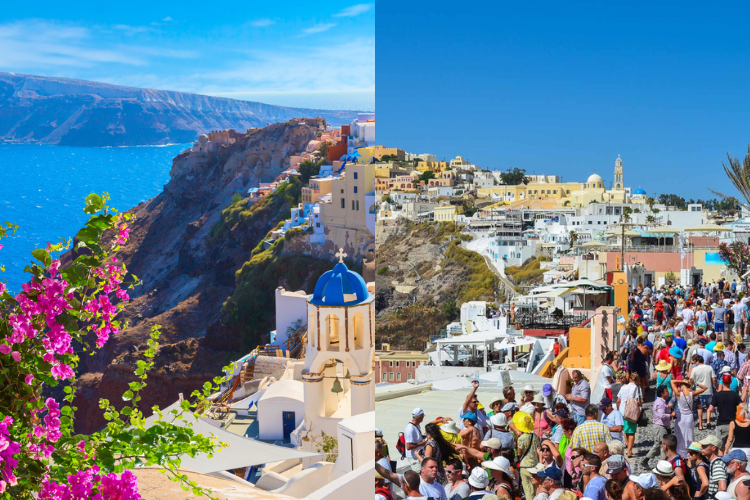
Tourism carries both positive and negative consequences. While it can stimulate economic growth, it can also lead to environmental degradation and the displacement of local residents.
For tourists, traveling offers a fantastic opportunity to expand their horizons and let their imagination roam free. But when countless individuals flock to the same destination year after year, there are some things that are left suffering from harm due to well-intentioned visitors like the places on this list.
Bali, Indonesia – 6.3 Million Tourists Per Year
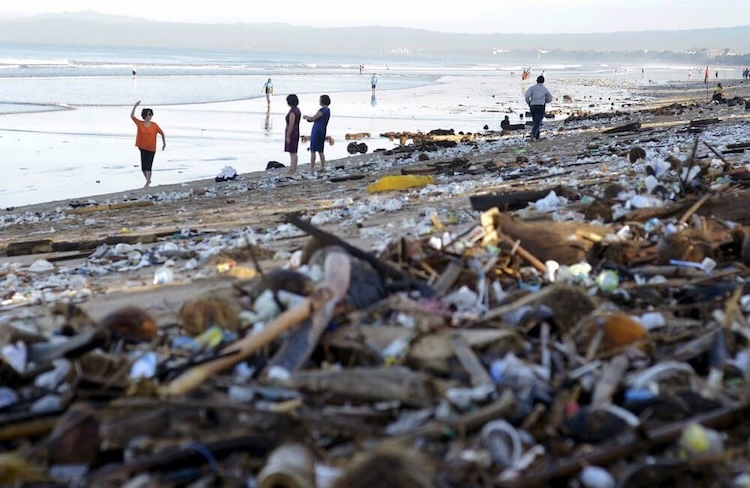
When we think of Bali, we often picture an image of tranquil paradise, but is that the actual picture? Over the last decade, Bali has grown in popularity, attracting over six million visitors annually.
While boom has certainly boosted the economy, yet some argue that it has diluted the island’s cultural and spiritual essence. Many voices on platforms like Facebook express their nostalgia for the Bali of old, while others believe this is a subject open to debate.
Venice, Italy – 5.5 Million Tourists Per Year

Venice’s charm lies in its extraordinary network of waterways, making it one of the world’s most distinctive destinations. While we’re used to houses connected by roads, Venice boasts houses standing on water, creating a captivating environment. This Italian city enjoys immense popularity, drawing approximately 5.5 million visitors each year.
While Venice thrives on tourism, it also presents challenges for its residents. During the peak tourist season, locals often face difficulties in carrying out their daily routines due to the sheer volume of visitors. This surge in tourism leads to longer queues and places additional strain on local services, a less glamorous aspect not commonly portrayed in movies.
Mount Everest, Nepal – 1,000 Tourists Per Year

Mount Everest stands as the ultimate challenge for seasoned climbers, but it’s no walk in the park. Climbers and their teams lug loads of gear, and even with the best intentions, they often leave behind a trail of debris, from food wrappers to oxygen tanks.
While the annual count of Everest climbers remains below 1,000, their environmental footprint is substantial. Furthermore, it’s not uncommon to witness large groups of climbers simultaneously scaling the mountain, making logistics quite a headache.
Petra, Jordan – 1 Million Tourists Per Year
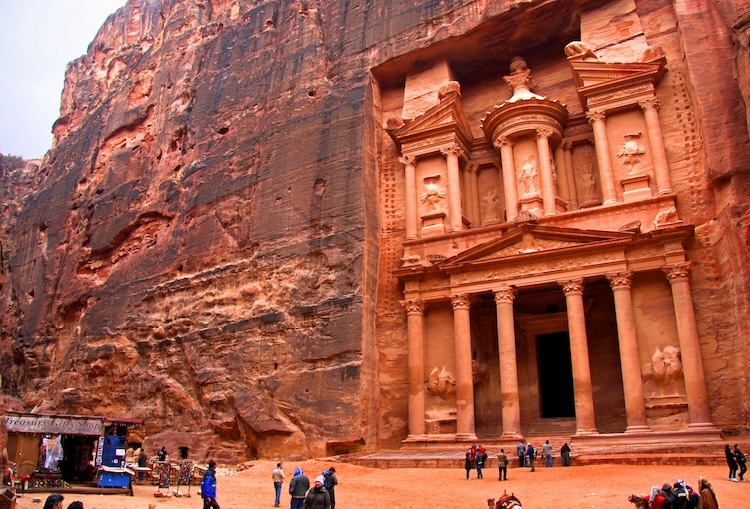
Petra, located in Jordan, holds significant historical value, boasting intricately carved temples nestled within stunning pink sandstone cliffs. Its beauty naturally draws tourists seeking an in-person experience. Nevertheless, the site’s fragility becomes apparent, enduring over a million visitors annually.
The pink sandstone, while captivating, is not the most robust material, susceptible to gradual erosion. Furthermore, concerns linger that the site’s sacred essence may fade as it bears the weight of the substantial annual influx of visitors.
Cozumel, Mexico – 4 Million Tourists Per Year
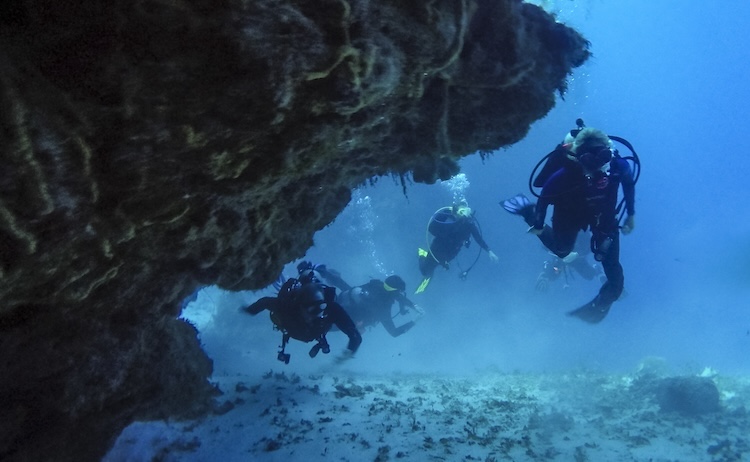
Cozumel, an enchanting island located just off the coast of Mexico in the Caribbean Sea, boasts stunning surroundings of crystal blue waters and breathtaking natural wonders. With its magnetic charm, it has become a favorite spot for tourists, attracting over 4 million visitors in 2018.
Despite its relatively small population of around 100,000 residents, the island faces challenges stemming from its booming tourism industry. Over-tourism is taking a toll on Cozumel’s delicate ecosystem, with some wildlife and coral reefs already endangered due to this increasing pressure on the island’s natural beauty.
Machu Picchu, Peru – 500,000 Tourists Per Year

Machu Picchu, a renowned Inca-era site in Peru, attracts over half a million visitors annually. While the majority of tourists show due respect, occasional accidents still happen. In a regrettable incident in 2020, a group of visitors explored the citadel at night, resulting in the collapse of a significant stone wall that formed part of the Temple of the Sun.
This incident, which caused the wall to tumble about 20 feet, also inflicted additional damage to the site’s flooring. The exact cost and complexity of repairing this priceless historical treasure remain uncertain, but it is undoubtedly a considerable undertaking.
Burning Man, USA – 80,000 Tourists Per Year

It’s quite a transformation to think about, but there was a time when Burning Man was a smaller gathering, reserved for a close-knit community. But as the years rolled on, the event’s fame grew, drawing more and more attendees. Today, approximately 80,000 people make their way to the festival annually.
Naturally, as you can imagine, the expenses of hosting this event have soared, impacting not only the festival itself but also the surrounding environment. The overall cost is estimated at around $10 million, with a substantial portion dedicated to the considerable cleanup efforts, given the strain the festival places on the Black Rock desert.
Pig Island, The Bahamas – 6 Million Tourists Per Year

When tourists visit the Bahamas, they typically anticipate various captivating sights. One unique location is Pig Beach on Exuma Island, where pigs swim in the water and tourists enjoy taking Instagram-worthy photos there, while it serves as a cherished home for a community of feral pigs.
Visitors absolutely adore watching these pigs frolic in the sand and take refreshing dips in the crystal-clear waters. You’ll likely stumble upon numerous snapshots of these endearing pot-bellied creatures on platforms like Pinterest. Unfortunately, with more tourists, some feed these pigs human food and garbage, harming their well-being.
Bubble Gum Alley, USA – 200,000 Tourists Per Year
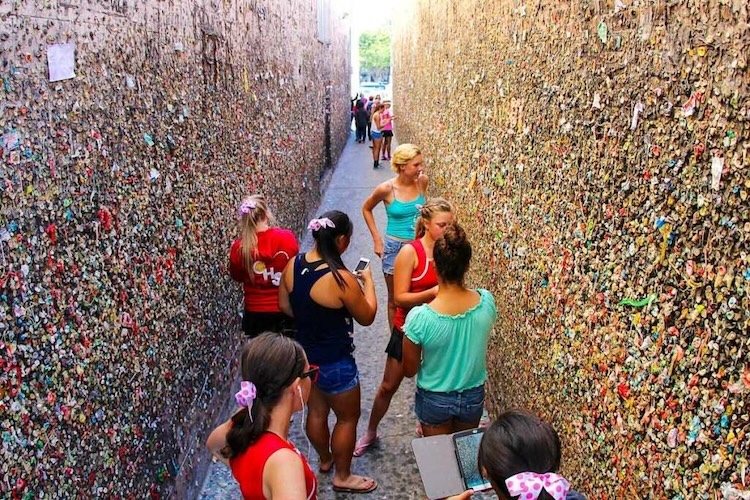
When it comes to unusual tourist attractions, Bubble Gum Alley in San Luis Obispo, California stands out. This downtown gem stretches 20 meters and is adorned with a colorful mosaic of chewed gum, a quirky attraction for many visitors.
While it may not top the list of hygienic destinations, it’s undeniably one of the most distinctive. The wall, now bearing tens of thousands of gum contributions, has sparked a debate among locals who view it as either a unique gem or an eyesore in need of repair.
Ibiza, Spain – 3 Million Tourists Per Year

Ibiza, an island in Spain, has long been a popular destination for partygoers looking to experience its vibrant club scene. The island offers a plethora of large bars and clubs, ensuring an exciting nightlife that draws in tourists by the masses.
However, while tourism is crucial for the region’s economy, it comes with its downsides. The unrestricted, all-you-can-drink atmosphere has taken a toll on Ibiza, resulting in various issues. The local culture has suffered, and the environmental impact, including noise pollution and litter left behind by revelers, has become a significant concern.
Lake Lucerne, Switzerland – 1.3 Million Tourists Per Year
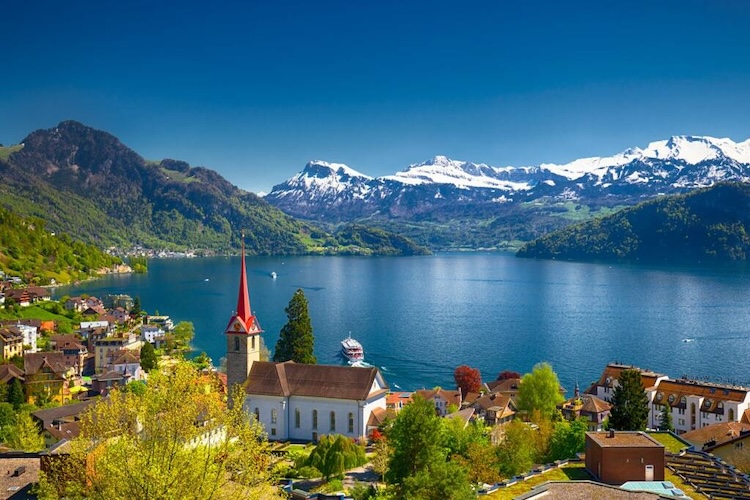
Switzerland, as a nation, is undeniably stunning, offering a plethora of natural marvels for travelers seeking respite. With a notable influx of more than 1.3 million tourists annually, the area’s charm sometimes contends with its popularity.
Lake Lucerne’s beauty is undeniable, but its popularity poses challenges. In 2018, during a cliff-diving event, the lake saw an overwhelming influx of visitors on inflatable rafts, creating a bumper-to-bumper situation that raised safety concerns, particularly regarding the risk of drowning.
Taj Mahal, India – 4.4 Million Tourists Per Year

The Taj Mahal, a captivating palace, draws in more than 4.4 million visitors annually and stands as one of India’s top tourist destinations. While it bolsters the country’s economy, it also grapples with overcrowding concerns.
To combat this, the local government raised ticket prices and imposed fines for extended stays. But inspite of these efforts, the Taj Mahal continues to attract hordes of visitors, making it challenging to capture the perfect photo of this iconic landmark.
Hanoi’s “Train Street”, Vietnam – 29 Million Tourists Per Year

Vietnam has long been a top choice for travelers, and there’s one unique spot that used to draw a crowd of tourists – the Train Street in Hanoi that features a 117-year-old railway track right through a vibrant street filled with cozy cafes and charming homes.
However, the charm of this place took a hit when the ever-increasing stream of selfie enthusiasts began causing safety concerns. With so many people stopping for photos, it became risky for the operational train track. Consequently, in 2019, the local authorities made the call to shut down the businesses along the street to discourage visitors.
Fjadrargljufur Canyon, Iceland – 300,000 Tourists Per Year

Iceland boasts numerous picturesque locations, with the Fjadrargljufur Canyon gaining global fame following its appearance in a 2015 Justin Bieber music video. As a result, its popularity skyrocketed, drawing over 100,000 additional visitors annually.
Once a cherished local spot, it turned into a global sensation, but the surge in tourists took a toll on the local ecosystem. In 2019, authorities had to temporarily close the canyon for essential maintenance due to the environmental impact.
Komodo Island, Indonesia – 50,000 Tourists Per Year

In recent years, the Indonesian government has grown increasingly worried about the state of Komodo Island. The breathtaking natural beauty of the island has been attracting a growing number of visitors annually, which poses a significant concern since it is a designated conservation area.
To address this issue, the authorities have implemented a visitor limit, allowing no more than 50,000 registered members to visit the island each year. Furthermore, they’ve prohibited the construction of hotels and other accommodations on the island to safeguard the habitat of the precious but limited population of Komodo dragons that still call this place their home.
Bronx, USA – Unknown

In 2019, the acclaimed movie “Joker,” starring Joaquin Phoenix, made waves by winning Oscars and garnering widespread praise. However, its influence on the daily lives of Bronx locals was unforeseen. One of the movie’s iconic scenes showcases Phoenix’s Joker dancing on stairs in the local neighborhood.
Following the film’s release, these stairs have become a popular spot for visitors, with many stopping to capture selfies. Unfortunately, not all tourists have been received warmly, leading to incidents like egg-throwing at selfie-takers in 2020, highlighting the need for respectful behavior when visiting the area.
The Great Pyramids, Egypt – 14.7 Million Tourists Per Year
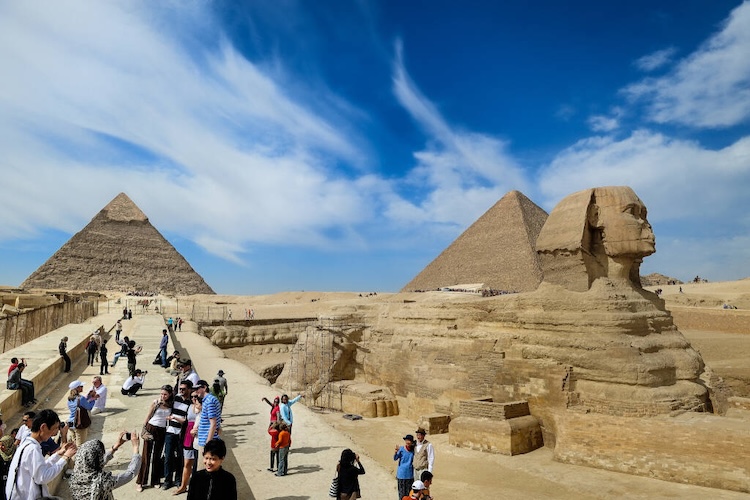
The Great Pyramids of Egypt are a must-see for vacation enthusiasts, offering a once-in-a-lifetime experience. Despite their enduring beauty and the significant revenue they generate for Egypt, the pyramids face a challenge – they won’t last indefinitely.
These incredible structures were designed to stand the test of time, but the sheer volume of visitors each year poses a threat. Unintentionally, tourists can inadvertently cause damage by bustling through, brushing bags against the walls, and even exhaling moisture into the passageways. Many believe that this influx of tourists may ultimately jeopardize this wonder of the ancient world.
The Spanish Steps, Italy – 100,000+ Tourists Per Year

The iconic Spanish Steps in Rome serve as a picturesque spot for photos, yet they’ve endured considerable wear and tear. In recent years, officials have implemented a stringent “no sitting” policy to address this.
Today, sitting on the steps can result in fines exceeding 400 euros, making it challenging for families with young children, as strollers are also prohibited from touching the steps.
Stonehenge, UK – 800,000 Tourists Per Year
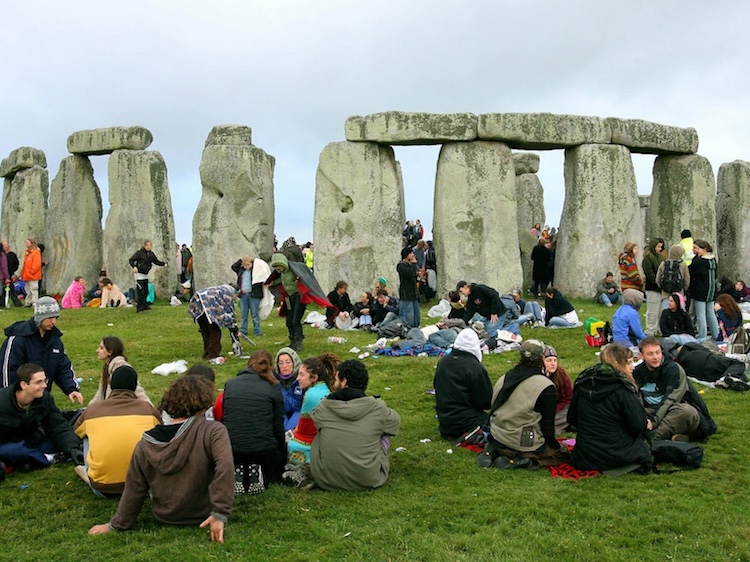
Stonehenge, located in the UK, is a designated world heritage site that captivates the imagination of both locals and tourists. Regrettably, recent visits to this ancient wonder no longer allow for the once-close interaction with the 6,000-year-old stones.
In the past, just a few decades ago, visitors could freely approach the stones and even touch them. But due to unfortunate incidents of vandalism and theft, the stones were cordoned off in 1977. As a result, while it remains an impressive sight from a distance, current visitors are unable to fully engage with the monument due to the actions of past tourists.
The Galapagos Islands, Ecuador – 150,000 Tourists Per Year

If you’ve ever tuned into a David Attenborough documentary, chances are you’re familiar with the iconic Galapagos Islands. This breathtaking locale is a haven for extraordinary species, making it a magnet for nature enthusiasts. However, despite not being a global tourism hub, the islands face the looming challenge of over-tourism.
With each new tourist, the demand for additional hotels grows, intensifying the environmental threat to this unique ecosystem. While tourism is beneficial for the local economy, striking a balance is essential to ensure the islands’ well-being.
Maya Bay, Phi Phi Islands, Thailand – 260,000 Tourists Per Year
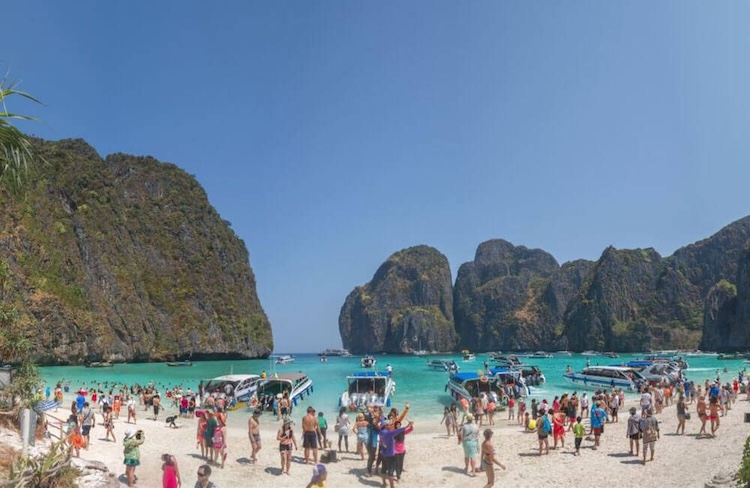
Thailand is home to stunning beaches, and one of its most famous ones gained its popularity from Leonardo DiCaprio’s movie, The Beach. Maya Bay attracted an ever-increasing number of visitors, peaking at over 5,000 a day by 2019, which overwhelmed the locals.
Consequently, the authorities had to close it down due to significant environmental damage. The closure was extended for an additional two years to allow the environment to recover. When it eventually reopens, visitors can expect stricter rules to protect the pristine beauty of the bay.
Cave of Altamira, Spain – 100,000+ Tourists Per Year
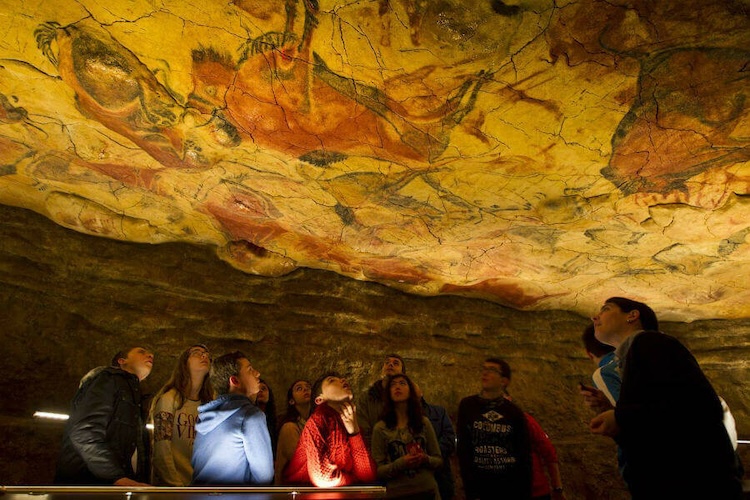
The Cave of Altamira in Spain has been a fascinating site due to its ancient wall paintings. While it was once open to the public, it closed in 1977 to protect the delicate artwork from damage. Although there was a brief reopening in 1982, mold issues led to its closure in 2002.
Since then, discussions have come and gone about reopening the cave, but it remains off-limits to visitors. Reopening it is a delicate matter, as it could risk the preservation of these invaluable paintings.
Santorini, Greece – 2 Million Tourists Per Year
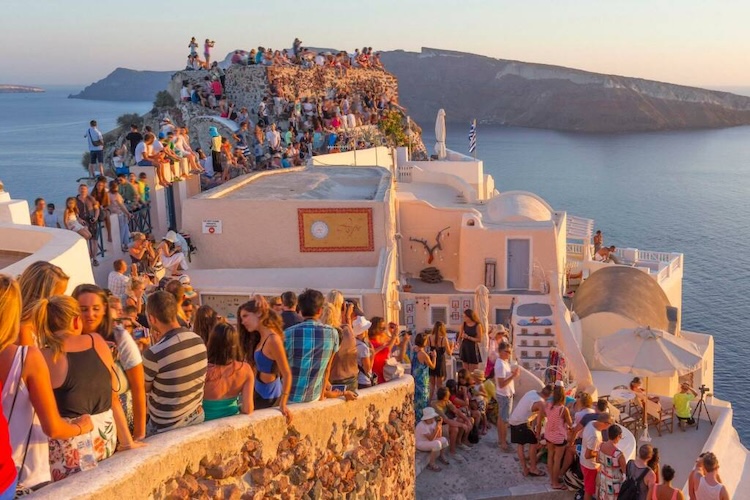
Santorini, Greece stands as one of the world’s most breathtaking destinations, renowned for its stunning vistas and charming architecture. The iconic white cubic houses perched atop the hills offer irresistible photo opportunities, often tempting visitors to clamber up walls for that picture-perfect shot.
While Santorini boasts age-old charm, it bears the scars of time, with some structures showing signs of wear and tear. When you add the staggering annual influx of over two million tourists, it becomes evident that the local government faces a considerable financial burden to mend the wear and tear inflicted by enthusiastic Instagram enthusiasts.
Pont Des Arts, France – 30 Million Tourists Per Year

The Pont Des Arts bridge in Paris, France is a beloved spot for both couples and tourists. It stretches gracefully over the Seine River, but it’s not just its architecture that makes it famous. Since 2008, visitors have been attaching padlocks to the bridge to symbolize their love, then tossing the keys into the river.
While this romantic tradition is undeniably sweet, the sheer number of locks began to take a toll on the bridge. By 2015, over a million padlocks adorned the bridge, compelling the government to remove them and replace the panels.
Duckbill, USA – Unknown

Duckbill in Oregon was renowned for its distinctive rock formation resembling a duck’s head. It was a popular spot for photography, sightseeing, and exploring the surrounding areas. However, in 2016, the iconic formation met an intentional demise.
During that year, a group of individuals reportedly pushed the rock formation until it tumbled down, citing concerns about a friend who had suffered a leg injury while climbing it. Understandably, the local community did not take kindly to this incident.
Isla de Sa Porrassa, Spain – 10 Million Tourists Per Year
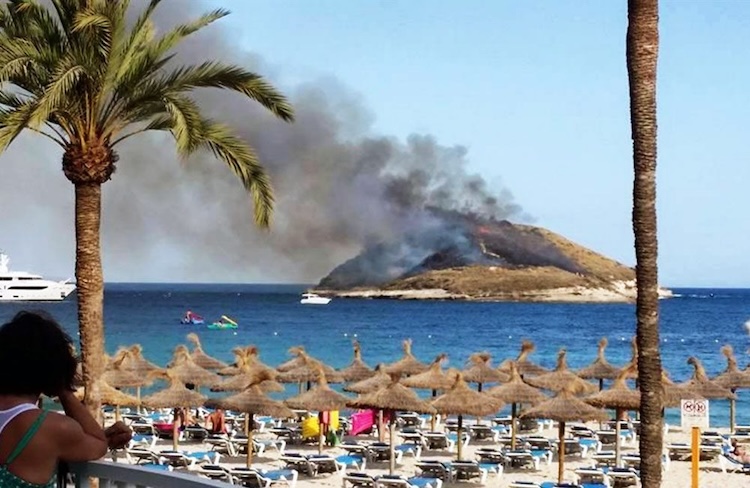
Isla de Sa Porrassa, situated in Majorca, Spain, graces the heart of Magaluf Bay with its stunning natural beauty. This captivating island, though uninhabited, remains a pristine gem, despite some unfortunate instances of tourist vandalism.
Regrettably, the island faced a significant fire incident ignited by two teenagers who carelessly tossed lit cigarettes onto the dry grass. This unfortunate event caused substantial damage to the island, sparking frustration among environmental rights advocates. Surprisingly, the teenagers issued an apology for their “clumsy” actions, but they escaped arrest and charges, leaving activists deeply concerned about the consequences.
The Coliseum of Rome, Italy – 6 Million Tourists Per Year
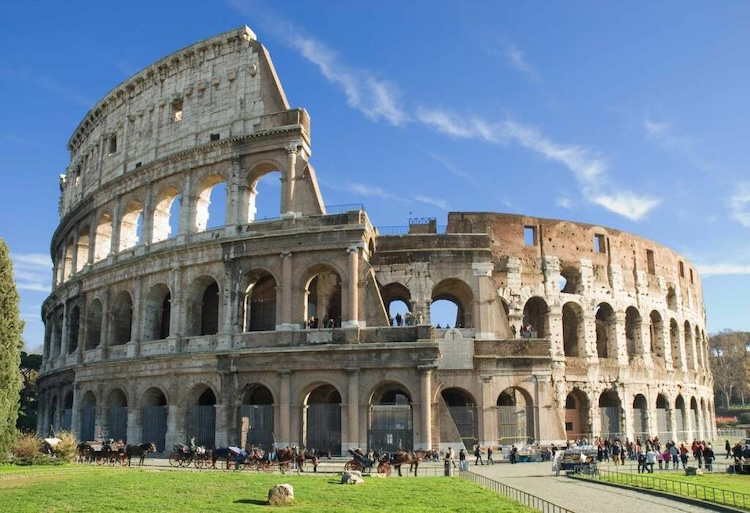
The Colosseum’s ruins initially resulted from a series of fifth-century A.D. earthquakes, aggravated by neglect. By the 20th century, two-thirds of the structure had crumbled. Today, these ruins are a major tourist draw in Rome, contributing to the city’s economy.
However, this surge in tourism has posed challenges for Roman officials striving to preserve the site’s sanctity. In 2017, they contemplated implementing “no-go zones” around the Colosseum to deter tourists from trespassing on the ancient remains.
Cuba – 600,000+ Million Tourists Per Year
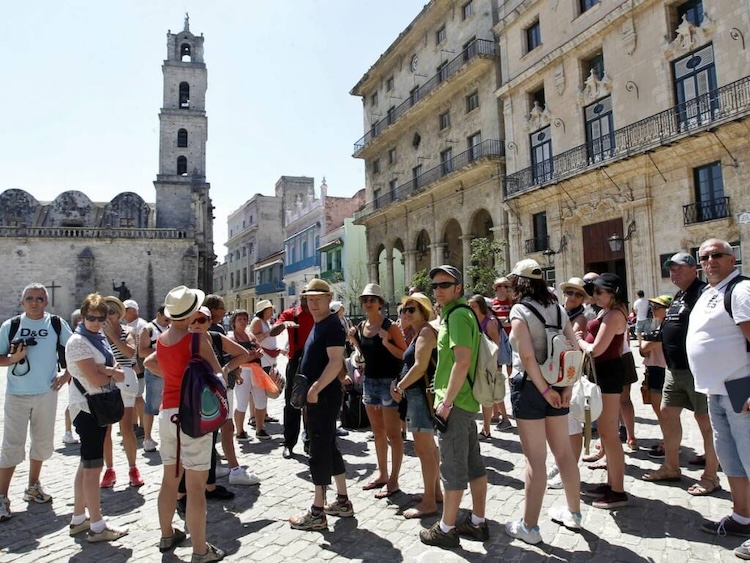
As per a report from Business Insider, Cuba witnessed a surge in tourism before a substantial influx of approximately 600,000 American visitors. Historically, political barriers had kept Americans away from the country, but signs of the embargo easing began to emerge in 2015.
Visitors from other countries came to Cuba in groups during this time, fascinated by the beautiful buildings and long, clean beaches. However, it is unclear what effect tourists from America might have on the country. This worrying possibility worries travelers like Guy Ben Aharon from Israel, who wants to see Cuba’s special appeal before it becomes well-known to the “American world.”
Orphanages in Cambodia – 6.61 Million Tourists Per Year

Cambodia’s famous attractions like Angkor Wat draw a significant number of tourists, but there are concerns about respectful behavior. While photography is allowed, there have been instances of tourists not adhering to appropriate dress codes. A major concern in Cambodian tourism is the welfare of vulnerable populations, especially children and the visually impaired.
Cambodian orphanages have become popular tourist attractions, partly due to the influence of Angelina Jolie and her adoptions. However, these orphanages often exploit children by having them ask for donations at restaurants, which negatively impacts their education. Locals are worried about preventing orphanages from becoming tourist hotspots.
Museum Island, Germany – 2.3 Million Tourists Per Year
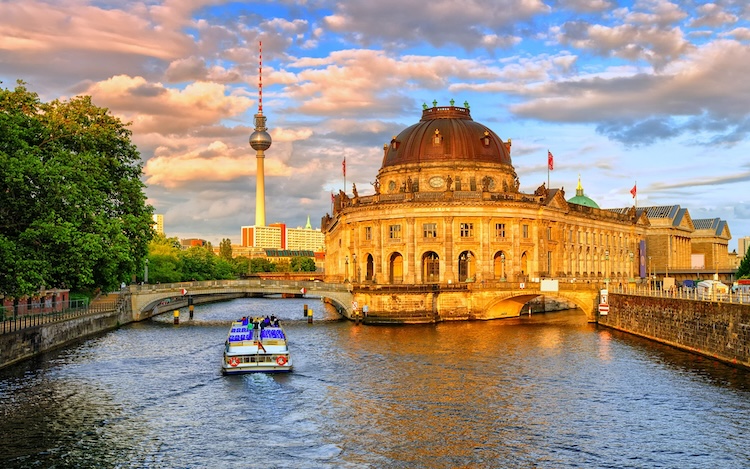
Berlin’s Museum Island is a renowned global artistic hub that attracts a substantial number of tourists annually. While many visitors appreciate the invaluable art pieces, regrettably, not all show the same respect. Unfortunately, the actions of a few tourists can result in significant damage to this cultural treasure.
According to a report by ABC News, Museum Island has been marred by acts of vandalism. In one distressing incident, teenagers spray-painted a granite bowl outside the Altes Museum, while another incident involved over sixty art pieces being damaged by an oily liquid that was smeared on them. Such vandalism inflicts substantial financial losses, ranging from thousands to potentially millions of dollars, each time an incident occurs.
The Little Mermaid Statue, Denmark – 1 Million Tourists Per Year

Situated in the heart of Copenhagen, Denmark, you’ll find “The Little Mermaid,” a charming bronze sculpture inspired by Hans Christian Andersen’s beloved fairy tale. This iconic statue has graced the city since the early 1900s, although it has sadly fallen victim to vandalism on several occasions, often during protests.
In the 1960s and again in 1988, Situationist activists removed the head of “The Little Mermaid.” More recently, in June 2020, protesters left their mark by tagging the statue with the words “RACIST FISH,” leaving many bewildered as they tried to understand the perceived racial insensitivity behind this act.
Times Square, USA – 50 Million Tourists Per Year

The tourism industry in New York City is significantly impacting the city’s daily life, as highlighted by VICE. Reviews on TripAdvisor echo these sentiments, frequently noting concerns about overcrowding, litter, and occasional incidents of violence. Times Square, in particular, has earned a reputation as one of the most challenging areas due to the influx of tourists, as described by SpoiledNYC.
Tourists inundate the sidewalks, often disregarding the request to walk at a reasonable pace or keep right, creating a chaotic atmosphere in Times Square. Coupled with exorbitant prices aimed at capitalizing on the tourist influx, this situation can make the overall experience rather unpleasant.
Eiffel Tower, France – 5.84 Million Tourists Per Year

According to a report from Stuff, the substantial surge in tourism in Paris, especially in popular spots like the Eiffel Tower, has become a source of concern for long-time city residents. Arnaldo Gomes, a Paris resident since the 1970s, described the tourists as noisy and messy, which has significantly impacted their daily life.
Every day, thousands of tourists flock to the Eiffel Tower, leading to traffic congestion and occasional friction with the locals. To address this, Paris is making changes to the area around the tower to create a garden that is more welcoming to the community. This is similar to what the Louvre did when it closed temporarily because there were too many people and not enough resources to handle them.
Antarctica – 78,500 Tourists Per Year
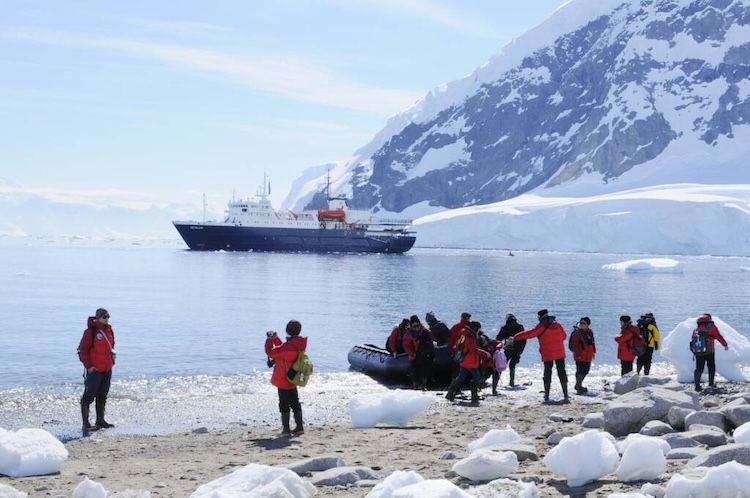
In the world’s coldest region, Antarctica, tourists and research scientists, while rare, can inadvertently harm the delicate ecosystem by carrying plant spores and seeds from other places. This unintentional action leads to toxic damage, as reported by the BBC.
Moreover, the area faces threats from passing cruise ships, posing risks of pollution and litter, including the constant danger of oil spills. Expedition cruises resumed in November 2021, and it is crucial that their impact is minimal to preserve the pristine beauty of Antarctica.
Great Wall of China – 10 Million Tourists Per Year

Aggravating the Chinese government should be avoided, especially when visiting the iconic Great Wall of China. This ancient landmark, which has stood the test of time, unfortunately, has not been spared from acts of vandalism.
In 2020, shortly after the Great Wall’s reopening, the Badaling section had to be closed for several months due to a regrettable incident. On the first day the public was allowed to visit, a tourist was caught on camera defacing the Wall with a key. This act, along with other similar incidents, prompted China to create a “blacklist” of banned tourists to ensure the protection of this historical treasure.
San Clemente Pier, USA – 2 Million Tourists Per Year
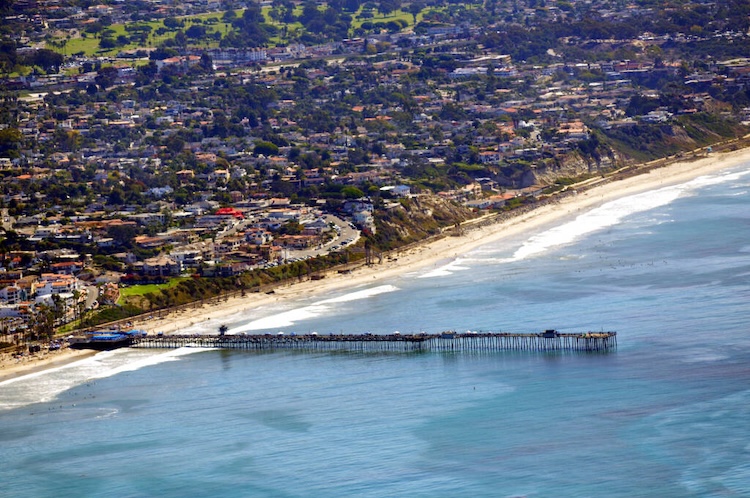
When you picture California, what likely comes to mind are its stunning coasts, sunny beaches, and those iconic palm trees. Of course, let’s not forget about the celebrities who call it home. However, it’s worth noting that a few tourist hotspots in the state are grappling with a rather unsightly issue – litter left behind by beachgoers.
Take, for instance, the case of San Clemente Pier. Situated in Los Angeles and located in Orange County, this beach has unfortunately earned a less-than-enviable reputation as one of the area’s dirtiest.In fact, Heal the Bay, a group that works to fight pollution, regularly tested the ocean waters. The results were not good: there was a high amount of bacteria that indicates the presence of feces.
Guanabara Bay, Brazil – 2 Million Tourists Per Year

Rio de Janeiro stands out as a captivating tourist destination in Brazil, renowned for its vibrant, colorful streets adorned with historical landmarks and attractions. Not to mention the stunning beaches that Brazil is celebrated for, boasting some of the world’s most beautiful sandy shores.
On the other hand, Guanabara Bay, situated within Rio de Janeiro, sadly doesn’t fit this description. Back in 2016, shocking images revealed the unfortunate state of the beach, as tourists left litter and filth in their wake, just before the Olympics. Thankfully, due to global outcry, Guanabara has hopefully seen some improvements in its condition since then.
Cancun, Mexico – 6.15 Million Tourists Per Year

Yahoo! recently raised the question of whether tourism has negatively impacted idyllic destinations, with Cancun in Mexico serving as a prominent case study. Attracting more than six million visitors annually, Cancun’s transformation from a pristine locale to a bustling resort hub is evident in satellite imagery, showcasing the loss of its natural charm.
Though Cancun retains its beauty, it has undergone the unfortunate loss of its mangrove swamps, which acted as a natural barrier against hurricanes. The demolition of these swamps to make room for resort hotels and other structures has heightened the area’s vulnerability to severe tropical storms and hurricanes.
Starved Rock State Park, USA – 2.3 Million Tourists Per Year

Starved Rock State Park, located in Illinois, boasts numerous sites of deep significance to Native Americans, including ancient sandstone formations dating back over 400 million years. It’s imperative that these formations remain untouched, both for preservation and religious reasons.
But in 2019, a few tourists who were visiting the park on Labor Day didn’t listen. They defaced the sandstone formations by inscribing their initials. Although their identities were uncovered on Twitter, the consequences of their actions remain unknown. This incident understandably stirred outrage among the Native American community, who have cherished this sacred site as a meeting place for millennia.
Kota Kinabulu, Malaysia – 3.89 Million Tourists Per Year

Malaysia boasts an abundance of picturesque coastal towns, beaches, and thriving commercial areas, making it a truly stunning destination. However, there’s an unfortunate downside to one of its coastal gems – Kota Kinabalu. Situated in the northeastern part of the country, this once-beautiful beach town now grapples with a pressing issue of accumulating trash and marine debris.
Pictures of Kota Kinabalu show a sad sight, with plastic bottles scattered on its beautiful shores. These thrown-away items not only spoil the natural beauty but also cause a big environmental problem, as they release harmful chemicals into the sand and harm the marine life nearby. Like some popular beaches in Thailand and Singapore, Malaysian tourist spots are finding it difficult to effectively handle the litter left by visitors.
Sardinia, Italy – 3.44 Million Tourists Per Year
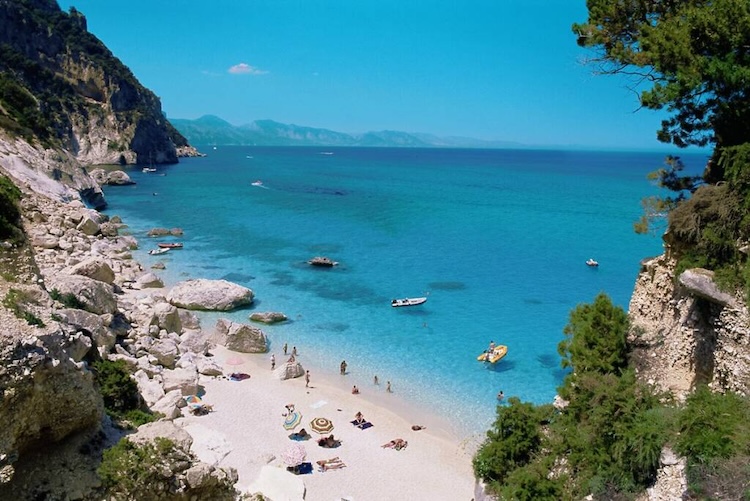
The Italian island of Sardinia, like many other beautiful island destinations, is a true paradise. However, it seems that a couple of French tourists recently found themselves in quite a bit of trouble for attempting to bring a significant chunk of that paradise back with them.
These tourists were actually arrested when they tried to smuggle an astonishing ninety pounds of sand from Sardinia’s stunning Chia beach. To pull off this caper, they cleverly stashed the sand in fourteen plastic bottles, but their plan was foiled when they tried to sneak their sandy contraband onto a ferry bound for France. Surprisingly, sand theft by tourists has become a considerable issue on Sardinian beaches, leading to significant damage to these pristine shores.
Piazza Bodoni, Italy – 794,000 Tourists Per Year
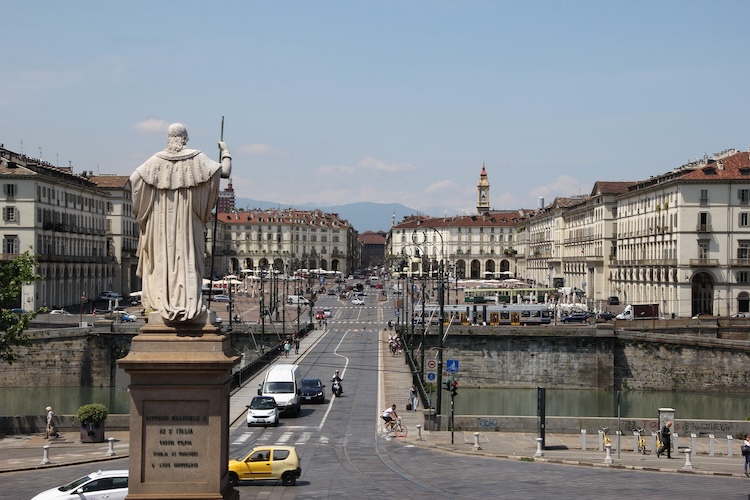
The Italian island of Sardinia, like many other beautiful island destinations, is a true paradise. However, it seems that a couple of French tourists recently found themselves in quite a bit of trouble for attempting to bring a significant chunk of that paradise back with them.
These tourists were arrested for trying to smuggle a whopping 90 pounds of sand from Sardinia’s beautiful Chia beach. They hid the sand in fourteen plastic bottles, but their plan failed when they tried to bring the illegal sand onto a ferry to France. Sand theft by tourists has become a big problem on Sardinian beaches, causing significant damage to the pristine shores.
Juhu Beach, India – 6 Million Tourists Per Year
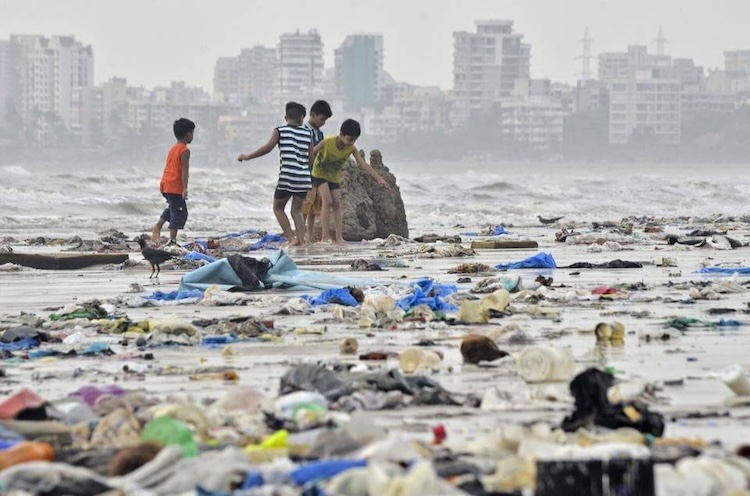
India, a country teeming with rich culture and diverse people, is not just a cherished tourist hotspot but also boasts a coastline that embraces three captivating seas: the Laccadive, Arabian, and the Bay of Bengal. The city of Mumbai, nestled along the coast, is popular among travelers because of its beautiful beaches and the Arabian Sea. However, some of India’s beaches are not as charming as they could be due to a serious litter problem.
Juhu Beach, in particular, is heavily affected by this issue. If you take a closer look at certain areas of the beach, you will see a distressing sight: plastic bottles, paper containers, and different types of waste covering the sandy shoreline. As a result, this litter problem has discouraged tourists from visiting Juhu. We hope that by reducing the number of visitors, we can expect a cleaner and more beautiful beach in the future.
Ngurah Rai International Airport, Indonesia – 12 Million Tourists Per Year

Bali isn’t just a typical tourist spot; it’s a major gateway for visitors. The island sees a significant influx of tourists, and nearly all of them pass through I Gusti Ngurah Rai International Airport. Unfortunately, there have been instances of tourists displaying unacceptable behavior at this airport.
One notable incident involved Auj-e Taqaddas, a British tourist, who was arrested for physically assaulting an immigration official. The incident, captured on video, occurred when Taqaddas became agitated about having to pay a fine for overstaying her travel visa by 160 days, a common issue among tourists. As a consequence, she received a six-month prison sentence in Indonesia.
Kamilo Beach, Hawaii – 850,000 Tourists Per Year
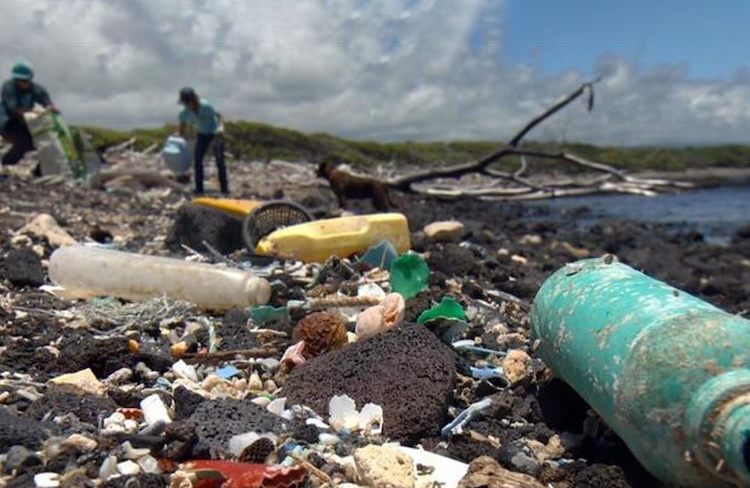
Hawaii is undeniably one of the most captivating places on Earth, boasting its unique culture and identity that sets it apart from the rest of the US. It’s a highly sought-after destination for travelers in search of an island paradise. However, its beauty is overshadowed by a sad reality at Kamilo Beach. This once stunning shoreline is now plagued by trash, pollution, and marine debris.
Studies show that a shocking 90% of the shoreline is covered in plastic, which is a direct result of the increase in tourism. Unfortunately, Kamilo Beach is not the only beach suffering from this litter crisis. According to reports from The Washington Post, Hawaiian beaches are currently overwhelmed with large amounts of plastic waste.
Denver Art Museum, USA – 800,000 Tourists Per Year

American museums typically maintain stringent security measures, making it seemingly inconceivable for vandalism to become an issue. Nonetheless, an unfortunate incident occurred at the Denver Art Museum in December 2018. During this time, a tourist named Jake Siebenlist went on a destructive rampage, causing significant damage to ten invaluable art pieces.
It’s worth noting that officials attributed Siebenlist’s actions to a state of mind that was far from “reasonable.” Some of the art destroyed during this regrettable episode dated back to the second century. While such an incident is unlikely to recur, it remains significant due to the substantial loss of ten art pieces, underscoring the gravity of the situation for the museum.
Phu Quoc, Vietnam – 5.1 Million Tourists Per Year

Phu Quoc, located in the south of Vietnam, is a must-visit place. The tourism industry has boosted Phu Quoc’s economy, but it has also impacted the beautiful beaches. According to Thanh Nien News, the mix of hotel waste and litter from tourists has made Phu Quoc’s once clean beaches one of the most polluted in the world.
Regrettably, the beautiful beaches of Phu Quoc now bear the brunt of food containers, plastic bags, water bottles, and other debris, with tourists being the primary contributors. Local establishments such as restaurants and hotels have also come under scrutiny, as they’ve been criticized for discharging wastewater and trash into the sea and for permitting some diners to behave irresponsibly on the beach.
International Arts Center Main Avenue, Russia – 6.4 Million Tourists Per Year

Certainly, taking occasional selfies isn’t a problem. However, in 2018, a group of women at Yekaterinburg’s International Arts Center took it to an extreme. They attempted to take pictures with original paintings by Salvador Dali and Francisco Goya, but accidentally knocked over the entire wall, damaging the frames, protective glass, and even the canvas of these valuable artworks.
Despite the significant damage caused, the local police chose not to press criminal charges against the women involved, which sparked discussions about responsible behavior in public spaces and the consequences of excessive selfie-taking.
Tha Pae Gate, Thailand – 4 Million Tourists Per Year

Tha Pae Gate stands as a cherished Thai tourist destination, boasting a history that reaches back to the thirteenth century, immersing visitors in a tangible connection with the past. Unfortunately, the site has faced significant challenges, with issues like intoxicated tourists and graffiti cans tarnishing its legacy.
In a regrettable incident, two tourists, Lee Furlong and Brittney Schneider, under the influence of alcohol, came across a spray paint can near Tha Pae Gate. Their actions resulted in defacing the beloved attraction and, in turn, led to them facing a daunting ten-year prison sentence.
Nazca Lines, Peru – 4.37 Million Tourists Per Year

In Peru, the Nazca Lines stand as enigmatic wonders, etched into the country’s landscape from ancient times. These intricate geoglyphs, numbering around 10,000 lines and comprising three-hundred diverse figures, have long fascinated both locals and tourists alike.
However, a regrettable incident marred the site’s sanctity in 1998. Disrespectful tourists, in a pickup bearing a California, USA license plate, recklessly crossed protective barriers, damaging three precious lines. Their irresponsible overnight camping left not only a mark on the lines but also a trail of garbage. Despite the global outcry, the culprits were never identified, underscoring the importance of preserving these historic marvels.
